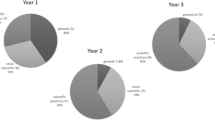Abstract
This article sets out to examine how meaning is made in classroom activities during a science class in lower secondary school. The analysis presented is based on video recordings and observations in a class with 15-year-old students. The findings consist of three themes. First, a great emphasis was put on precision and second, on procedures. Students’ questions and suggestions regarding the lesson content were handled in a way that favored these two components. Third, findings identify precision and procedures as two nonnegotiable features of school science. It is suggested that if the rationales for these features of school science are communicated to students, their participation in, and understanding of, the enterprise are facilitated.
Résumé
Cet article propose d’analyser comment les signifiés sont créés au cours des activités en classe dans les cours de sciences au premier cycle du secondaire. Notre analyse se fonde sur des enregistrements vidéo et des observations de classe portant sur des élèves de 15 ans. Les résultats portent sur trois aspects. D’abord, une grande importance a été accordée à la précision. Ensuite, ce sont les procédures qui ont retenu notre attention. En effet, les questions et suggestions des étudiants au sujet du contenu des leçons ont été traitées de façon à favoriser ces deux composantes. Troisièmement, les résultats indiquent que la précision et les procédures sont deux aspects non négociables des cours de sciences à l’école. Nous estimons que, si la raison d’être de ces composantes des cours de sciences sont communiquées aux étudiants, cela favorisera leur niveau de participation et de compréhension.
Similar content being viewed by others
References
Brown, J. S., Collins, A., & Duguid, P. (1989). Situated cognition and the culture of learning. Educational Researcher, 18, 32–42.
Carlgren, I. (1999). Pedagogiska verksamheter som miljöer for lärande. In I. Carlgren (Ed.), Miljöer for lärande (pp. 9–23) Lund: Studentlitteratur.
Delamont, S., Beynon, J., & Atkinson, P. (1988). In the beginning was the Bunsen: The foundations of secondary school science. Qualitative Studies in Education, 1(4), 315–328.
Gaskell, P. J. (1992). Authentic science and school science. International Journal of Science Education, 14(3), 265–272.
Hogan, K. (2002). Exploring a process view of students’ knowledge about the nature of science. Science Education, 85, 51–70.
Khishfe, R., & Abd-El-Khalick, F. (2002). Influence of explicit and reflective versus implicit inquiry-oriented instruction on sixth graders’ views of nature of science. Journal of Research in Science Teaching, 39(7), 551–578.
Lave, J. (1996). The practice of learning. In S. Chaiklin & J. Lave (Eds.), Understanding practice (pp. 3–32). Cambridge: Cambridge University Press.
Lidar, M., Lundqvist, E., & Östman, L. (2006). Teaching and learning in the science classroom. Science Education, 90, 148–163.
Lundin, M., & Lindahl, M. (2005). Experiences and their role in science education. Journal of Baltic Science Education, 1(7), 31–39.
Munby, H., Cunningham, M., & Lock, C. (2000). School science culture: A case study of barriers to developing professional knowledge. Science Education, 84, 193–211.
Osborne, J., Collins, S., Ratcliffe, M., Millar, R., & Duschl, R. (2003). What “ideas-about-science” should be taught in school science? Journal of Research in Science Teaching, 49(7), 692–720.
Östman, L. (2003). Transaktion, sociokulturella praktiker och meningsskapande: ett forskningsprogram. In L. Östman (Ed.), Erfarenhet och situation i handling-en rapport från projektet Lärande i naturvetenskap och teknik (pp. 91–118). Uppsala: Uppsala Universitet, Pedagogiska Institutionen.
Ostman, L., & Roberts, D. A. (1994). Toward understanding the production of meaning in science education. Introduction to the theme. Nordisk Pedagogik, 1, 2–9.
Rico, S. A., & Shulman, J. H. (2004). Invertebrates and organ systems: Science instruction and “fostering a community of learners.” Journal of Curriculum Studies, 36(2), 159–181.
Schwab, J. J. (1978). Education and the structure of the disciplines. In I. Westbury & N. J. Wilkof (eds.) Science, curriculum, and liberal education (pp 229–274). Chicago: University of Chicago Pres
Schwartz, R. S., Lederman, N. G., & Crawford, B. A. (2004). Developing views of nature of science in an authentic context: An explicit approach to bridging the gap between nature of science and scientific inquiry. Science Education, 88(4), 610–645.
Wennerholm, S. (2005). Framtidsskaparna. Lund: Arkiv förlag.
Wickman, P.-O. (2004). The practical epistemologies of the classroom: A study of laboratory work. Science Education, 88, 325–344.
Wittgenstein, L. (1953). Philosophical investigations. Oxford: Basil Blackwell.
Wright, G. H. von (1986). Vetenskapen och Förnuftet. Stockholm: Bonniers.
Author information
Authors and Affiliations
Corresponding author
Additional information
This article was accepted by Dr. Derek Hodson.
Rights and permissions
About this article
Cite this article
Lundin, M. Meaning Making of Precision and Procedures in School Science. Can J Sci Math Techn 8, 25–34 (2008). https://doi.org/10.1080/14926150802152194
Published:
Issue Date:
DOI: https://doi.org/10.1080/14926150802152194




